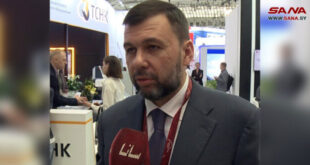Damascus, SANA-Seals possess keys to the secrets of life in ancient historical times, they are one of the most important archaeological finds from which the researcher in archeology inspires his/her information about previous eras, and Syria is the cradle land of the oldest discovered seals in the world, according to historian Dr. Mahmoud El-Sayyed.
This Syrian antiquities’ expert and reader of ancient inscriptions at the General Directorate of Antiquities and Museums said that in Syria, the oldest seals were invented and then spread to all parts of the world according to the current archaeological data. Archaeological Ras Shamra “Ugarit Kingdom” in Lattakia province is attributed to the second half of the seventh millennium BC. Then seals appeared in the form of a plug in 5800 BC. From this date, pottery colored in one color, brown and red on an orange background, appeared for the first time in the world.
At the site of “Abu Huraira” in Syrian Jazeera region, copies of a seal dating to the period between 6500-5500 BC were discovered. At Tal Abu Hurayrah, a flat seal made of pottery dating to the period between 6000-5500 BC was also discovered.
The expert went on to say that the use of seals on pots and baskets carrying goods, dated to the end of the sixth millennium BC were discovered in Syria. Those seals were also discovered at the site of Tal al-Sabi al-Abyad on the left bank of the Upper Balikh River. Most of them are geometric in shape, including zigzag lines, circles, triangles, and intersecting lines, some of which are engraved with the shapes of plants and animals. Like goats with big horns and deer.
 According to Dr. Al-Sayed, Syria possesses hundreds of seals, unique in content and very rare in the world, including a unique seal print, that has distinct characteristics in the structure and content of writing, as well as individual iconography. The seal was discovered in the Kingdom of Qatana, located in the province of Homs which dates back to the second millennium BC. It is engraved with a decorative frieze with ribbons, intertwined and divided into five indexes located on top of each other,
According to Dr. Al-Sayed, Syria possesses hundreds of seals, unique in content and very rare in the world, including a unique seal print, that has distinct characteristics in the structure and content of writing, as well as individual iconography. The seal was discovered in the Kingdom of Qatana, located in the province of Homs which dates back to the second millennium BC. It is engraved with a decorative frieze with ribbons, intertwined and divided into five indexes located on top of each other,
some carry writing in cuneiform script arranged in a column opposite the ornamental decoration twisted at an angle of 90 degrees, which is a very rare and only stamp in the world discovered so far for dual reading.
On the stone seal of “Ishkhi Adad,” the king of countries, and the Lord of his name, we read in the carved copy of the original inscription “Perhaps God Adad can save me.” In the reverse version of the print on the locks, we read Adad, a lord whose name is Ishkhi Adad, the king of countries.
According to the Syrian historian, a cylindrical seal of hematite dating from the eighteenth or seventeenth century BC was also discovered in the Kingdom of Qatana, on which were engraved very small images distributed in equal columns.
Of the illustrated symbols, there are 73 symbols. These symbols consist of people, hands, bull heads, lions, birds, Syrian sphinxes, and symbols that express the God.
Dr. El-Sayed concluded by saying that the above documents, with archaeological material evidence, Syria’s global role in laying the foundations of human civilization and dedicating the concept of using seals, and the benefits that this has achieved for humanity, which we are still reaping its fruits to this day.
Mohamed Emad Al-Daghly/ translated by Mazen Eyon
 Syrian Arab News Agency S A N A
Syrian Arab News Agency S A N A



